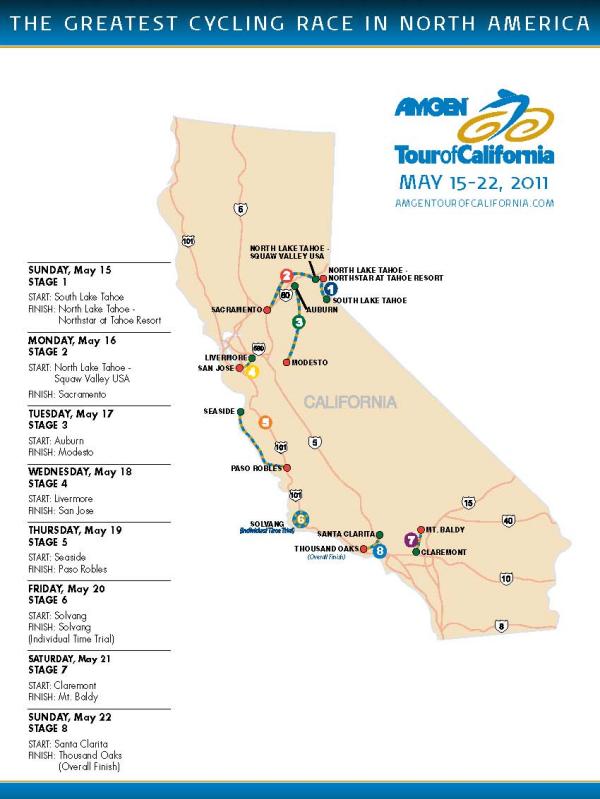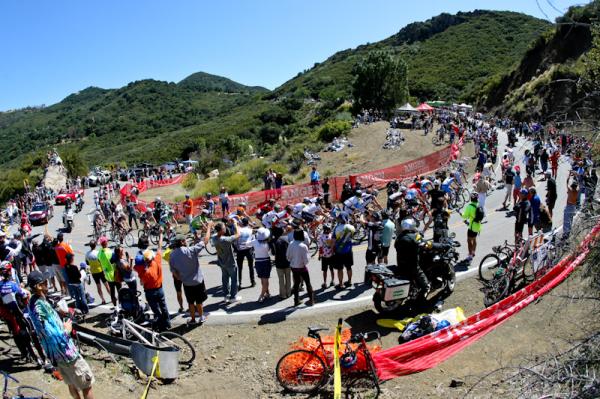Additional stages possible for future Amgen Tour of California editions
Race positions itself as key preparation for Tour de France



While the exact route details of the 2011 Amgen Tour of California won't be revealed until late December or early January, yesterday's unveiling of the 15 host cities and key highlights of the eight-day stage race reveals an event more primed than ever for its position as a must-do race for those with aspirations for the Tour de France later in the season.
A couple of key firsts were announced, including the first true mountain top finish at Mount Baldy for the penultimate stage as well as the tour's first trip outside California's borders, with a section in Nevada for the opening stage around Lake Tahoe. More than 50 cities applied to host either a stage start or finish, so is it inevitable that the Amgen Tour of California will add more stages to accommodate the demand and better position itself as an alternative to the concurrent Giro d'Italia?
"We are always looking at whether it makes sense for us to be an eight day race or whether for us to extend a little bit," said AEG president Andrew Messick. "I don't think we aspire to be a three-week race. I can envision us being a nine, 10, potentially even an 11-day race in the future. We want to be positioning ourselves as a race that is important and helpful for people that want to do well at the Tour de France.
"Being much longer than that starts to become more than what people are looking for. I don't think we get the riders. We get Andy Schleck, who's been at our race the past couple of years. An eight-day race in California in May is something that works really well for him because his overall objective is to be at his peak in July - same as Fabian Cancellara, same as a lot of guys.
"We want to be a great race on a stand alone basis, and I think we're making progress. If we start to become too hard, too challenging, then the guys who are serious about July may not choose to do our race."
For 2011 the race organisers balanced three critical criteria in order to create an event that provides ample opportunity for riders of every ambition, showcases as much of the state as possible, but also keeps undue logistical stress on the riders and teams to a minimum.
"One, our desire to create a great bicycle race that will be interesting, compelling and provide opportunities for athletes who are sprinters, who are hill climbers, who are time triallists, and who are contenders for the overall general classification to have a chance to be able to compete and compete effectively," said Messick. "For stages where there's going to be climbing we'd like the climbing to be as decisive as possible and we are trying to have fewer stages where there's big climbs early and more stages where there's big climbs late.
Get The Leadout Newsletter
The latest race content, interviews, features, reviews and expert buying guides, direct to your inbox!
"The second element critical in our route planning process is to be in places where we think bicycle racing is loved and appreciated and to be in places where we've had success in the past. We counterbalance that by wanting to go to new places. Every year we try to make sure we're able to bring the race to communities where the race hasn't been before.
"The last criteria is to make sure that for the athletes we've been able to create a manageable race and a manageable event which minimizes the number and length of athlete transfers, minimizes the distance between starts and finishes and keeps the stages at a manageable length given the time of year and the position of the season."
The inclusion of Mount Baldy as the event's first true summit finish is an important step in the race's evolution, and will provide a Tour de France-esque atmosphere for both riders and spectators.
"The climb up to Baldy is one of the most iconic and decisive climbs in Southern California," said Messick. "It's hard, it's beautiful, it has the characteristics that you want in a stage that's going to play a pivotal role in who wins the overall general classification of our race next year.
"There aren't too many stages like that, there aren't too many places where you can have an absolutely decisive finish and also have infrastructure at the top."
And as the Tour de France provides amateur cyclists a chance to ride a complete stage of the Tour each year, so too will the Amgen Tour of California.
"We will be having an event similar to L'Étape du Tour that will take place a few weeks before the race that will provide amateur athletes an opportunity to ride the entire stage seven of the Amgen Tour of California, finishing at the top of Mount Baldy. For recreational guys, they'll get the chance to feel the same burn that the pros are going to."
Based in the southeastern United States, Peter produces race coverage for all disciplines, edits news and writes features. The New Jersey native has 30 years of road racing and cyclo-cross experience, starting in the early 1980s as a Junior in the days of toe clips and leather hairnets. Over the years he's had the good fortune to race throughout the United States and has competed in national championships for both road and 'cross in the Junior and Masters categories. The passion for cycling started young, as before he switched to the road Peter's mission in life was catching big air on his BMX bike.